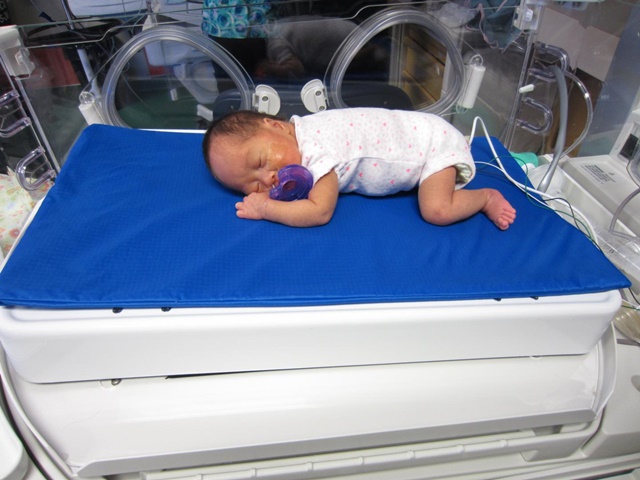26 Mar. 2021. Clinical trial results show a hospital bed that simulates contact with a mothers’ body helps preterm babies cope with unpleasant medical procedures. Findings from the trial, conducted by researchers from University of British Columbia in Vancouver, were published earlier this year in the journal Pain Reports, but the device more recently received initial funding from the university for further development.
The robotic device called the Calmer is designed to reduce stress in preterm infants who need close monitoring by clinicians in a neonatal intensive care unit, including regular tests like blood draws that can be painful, but in circumstances where the mother is not present to help. The Calmer is soft platform shaped like a pillow with programmable circuits and motors that replaces the mattress in a preterm baby’s incubator. The top surface is made of silicone and a biocompatible Goretex material to feel like human skin. The Calmer’s electronics can be programmed to simulate the mother’s breathing pattern and heartbeat, gently adjusting the top surface up to 10 millimeters.
A team from UBC’s occupational science and computer science faculties designed Calmer, with the first units built by colleagues at a product development lab at British Columbia Institute of Technology in Burnaby. Liisa Holsti, professor of occupational science and therapy led development of Calmer with computer science professor Karon MacLean, whose research group studies touch-based human interactions in robotics.
The clinical trial tested the Calmer in the neonatal intensive care unit at BC Children’s and Women’s Health Centre in Vancouver. The trial enrolled 54 infants born preterm at 27 weeks or later, with the infants randomly assigned to beds with or without a Calmer, where clinicians caring for babies without a Calmer used a technique called facilitated tucking, the standard care where the baby is held in flexed or tucked position.
The study team looked primarily for changes in behavioral indicators of infant pain during blood draws, but also tracked heart rate and blood oxygen levels in the brain, using near-infrared spectroscopy, a non-invasive technique where near-infrared wave reflections indicate changes in oxygen levels. A subset of the sample, 29 infants, were tested specifically for blood oxygen levels in the brain.
“For newborns and particularly for preterm babies,” says Manon Ranger, professor of nursing at UBC in a university statement, “it’s critical to keep overall blood oxygen levels steady, especially in the brain. The more stable their brain oxygenation is, the better for their brain development.” Ranger studies brain development in preterm babies and is first author of the Pain Reports paper.
The results indicate preterm babies in beds with a Calmer display blood oxygen levels similar to babies with human touch and facilitated tucking during blood draws. The authors conclude that a parent’s touch is still the best method for these circumstances, but the Calmer can substitute if necessary. Ranger notes, “This is especially relevant in the current Covid-19 pandemic context, where many hospital settings must restrict contact with visitors.”
“We are expanding our evaluation of this device in more rigorous real-world conditions,” adds Holsti, “and we’re in the process of redesigning it to be used in low- and middle-income countries, so that infants worldwide who need it can have the benefit of Calmer treatment.”
In February, the Calmer developers were one of six medical and engineering teams at UBC to receive Health Innovation Funding Investment or HiFi awards from UBC Health. The HiFi awards are given to encourage further development of the technologies into clinical practice.
More from Science & Enterprise:
- Trial Tests Non-Invasive Brain Bleeding Scanner
- Smart Walking System Wins Multiple Sclerosis Challenge
- Trial Shows Electronic Treatments Slow Brain Decline
- Micro Robotic Neuro Therapy Company Underway
- AI Harnessed for Patient Monitoring Analytics
* * *


 RSS - Posts
RSS - Posts
You must be logged in to post a comment.